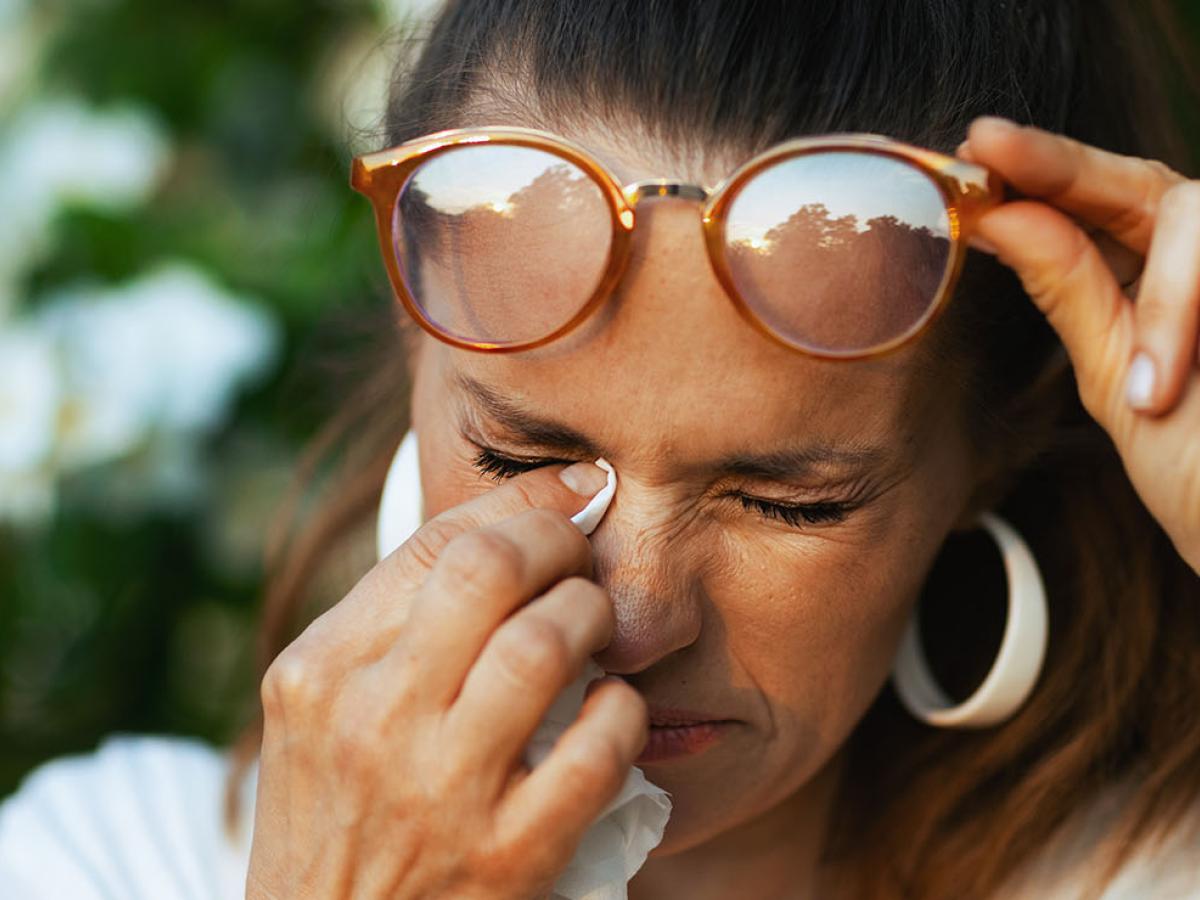May 20, 2024

You might think you’re off the hook if you’re an adult who’s never experienced seasonal allergies. If you had them, you’d know by now, right?
After all, environmental or inhalant (breathed-in) allergies usually develop around age 3 or 4 and peak in adolescence or early adulthood. Scientifically speaking, aging typically only causes these allergies to change when you reach your 70s. You may then experience fewer allergic reactions as your body’s immune system changes and weakens (immunosenescence).
But then why — just as the weather turns nice — are you suddenly rubbing your eyes, sneezing and dealing with a constantly leaking nose?

According to the Centers for Disease Control and Prevention (CDC), more adults than children have a seasonal allergy. To understand how that can be, we spoke with Dr. Christine Franzese, an MU Health Care otolaryngologist (ear, nose and throat doctor) who specializes in allergy and immunology.
Dr. Franzese explains what may be causing your seemingly new or worsening allergy symptoms — and what you can do to find relief.
Why It Feels Like You’re Developing Seasonal Allergies as an Adult
You can develop environmental allergies in response to outdoor triggers that change with the seasons (grass, pollen and weeds) and non-seasonal indoor triggers (dust mites, mold or pet dander).
“If you’re starting to notice allergy symptoms as an adult, it’s potentially something that was always there and just got worse,” Dr. Franzese says. “Untreated allergies can progress, and inhaled allergies can slightly evolve. But an increase in allergic reaction isn’t typically because of physical changes in your body — it’s determined by how much you’re exposed to the allergen.”
Your new or worsening allergy symptoms may be caused by:
Climate Change
The changing climate and warmer temperatures may increase your exposure to seasonal allergens. According to research, cases of allergic respiratory diseases, including allergic rhinitis and asthma, are rising due to climate change. Higher amounts of carbon dioxide and rising temperatures mean more airborne allergens, like pollen and fungal spores, get released.
“Warmer weather means longer growing seasons and atypical pollination patterns,” Dr. Franzese says. “As a result, you’re being exposed to pollen for longer periods and at odd times of the year.”
Geographical Changes
Seasonal allergens vary from place to place. If you move to a different region, you may encounter new or more highly concentrated allergens.
“It’s not uncommon for people to move away from their allergies,” Dr. Franzese says. “Different geographic regions have different trees, weeds and even grass types.”
But she explains that those geographic allergen lines are changing. “Some allergy conditions, like allergic fungal sinusitis, are known to have a geographic limit, only occurring in warmer climates,” Dr. Franzese says. “But now we are seeing those conditions further north. I’ve seen a noticeable uptick in allergic fungal sinusitis in Missouri this year.”
Changes in Your Daily Life
Sometimes, small changes that seem unrelated to allergens can increase your exposure and cause symptoms. Taking a close look at your lifestyle and medication changes may reveal the reason you’re feeling stuffy or itchy.
Everyday situations that may increase allergy symptoms include:
- Making lifestyle changes: During the COVID-19 pandemic, many people began working from home, got a dog or found a love for gardening. Those changes can increase your exposure to dust mites, pet dander or seasonal allergens.
- Stopping antihistamine medication: Antihistamines treat allergies by blocking histamine — a substance released when your immune system detects a threat. But doctors also prescribe antihistamines for other conditions, including stomach problems, anxiety and sleep problems. If you recently stopped an antihistamine medication, you may be experiencing your body’s natural reaction to an allergen.
- Using a new chemical-based product: While rare, some people may have mild environmental allergies that are worsened by a contact allergy — often a chemical used in one of your beauty or grooming products. This can cause red, inflamed eyes (eyelid dermatitis) and only occurs when both allergies are triggered.
How Are Seasonal and Environmental Allergies Treated?
When allergies go untreated, they can get worse or even trigger flare-ups of chronic conditions, such as:
- Chronic sinusitis: Allergies can worsen chronic sinus inflammation. If you have chronic sinusitis, you may notice sinus pain, a lessened ability to smell and thick, opaque nasal drainage instead of the clear drainage typically associated with allergies.
- Eosinophilic esophagitis (EoE): This swallowing disorder is challenging to diagnose and worsens with seasonal allergies.
Depending on the severity of your symptoms and allergies, there are many allergy treatment options available, including:
Medication
Allergy medication can help prevent an allergic reaction and reduce the symptoms. Most allergy medications are available over the counter (OTC). But Dr. Franzese notes that two new prescription nasal sprays are available: Dymista® and Ryaltris®. They combine antihistamines and nasal steroids (for inflammation) to treat seasonal allergies.
Allergy Immunotherapy
Immunotherapy weakens your body’s reaction to an allergen by exposing your immune system to controlled and increasing amounts of it. After three or four years, the treatment will desensitize your immune system to that allergen.
“Getting immunotherapy treatment early in life can be very helpful,” Dr. Franzese says. “Often, the more allergies someone has in childhood, the more likely they are to develop new allergies and related conditions like asthma.”
Immunotherapy types available for seasonal and environmental allergies include:
- Allergy shots: You’ll receive a weekly injection in your provider’s office at first. Over time, you’ll get the shots less often.
- Sublingual (under the tongue) tablets or drops: After taking the first dose in a doctor’s office (to monitor for a severe reaction), you’ll dissolve a tablet or drops under your tongue each day. It’s available for grass, dust mite and ragweed allergies.
- Immunotherapy toothpaste: This allergen-containing toothpaste can be effective for environmental allergies. Experts are also studying it for the treatment of peanut allergies.
Allergen Avoidance
For some people, the best treatment is avoiding the allergen. Pollen tracking apps can identify when and where seasonal allergen levels are high. Allergy testing can also be a good option for people unsure which allergen triggers their symptoms.
“Knowing what you are allergic to can be very helpful,” Dr. Franzese says. “You can consult a pollen-tracking app to avoid the allergen or target your medication use.”
When to See Your Doctor About Allergies
If your OTC medications control your symptoms, there’s no need to see a medical professional. But if you experience medication side effects, worsening symptoms or take two to three medications daily without much relief, it’s a good idea to get checked out.
Next Steps and Useful Resources
- Want to discuss with an allergy expert? Find one today.

